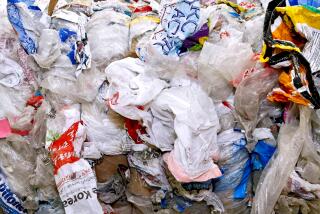Editorial: Compostable plastic? Not so much

Most people know by now that the disposable plastic used for take-out food is an environmental hazard. Containers, cups, utensils, straws — very little of it gets recycled and very much of it ends up polluting the oceans, lakes and rivers of the world.
That’s why many California cities and counties have adopted tight restrictions on its use by stores and restaurants and why state lawmakers are considering (and, we hope, passing) a new law to phase out most single-use plastic packaging that’s not recycled or compostable over the next decade.
Given the plastic trash backlash, it’s no surprise that forward-thinking retailers and restaurants are working hard to replace their conventional single-use plastic with so-called bio-plastic versions that, theoretically at least, will have a second life as soil-enriching compost. The plastic industry reports explosive interest in compostable plastic for food packaging, and that is projected to grow substantially in coming years.
That’s great, right? No more guilt that the drinking straw tossed into the trash might end up jammed in the nose of a sea turtle. One way or the other, it will become worm food eventually. Right?
Sorry, no. The disappointing reality is that compostable plastic is only a potential alternative at the moment, because it isn’t being composted in any substantial way as yet.
And why not? Part of the reason is that there’s confusion about what compostable plastic is. The word implies that it can be tossed in your backyard compost bin, where it will break down along with the leaves, coffee grounds and carrot tops into a lovely soil amendment. But compostable plastic is still plastic, even if made from plants like corn or sugar cane, and generally requires industrial processing to be rendered into compost. (Also complicating the situation is the fact that not all plastic made from plants can be composted and not all compostable plastic is made exclusively from plants.)
And that’s where the breakdown happens. Or rather, where it doesn’t happen.
Few cities have the infrastructure in place to process compostable plastic at the moment. (The city of Los Angeles, for example, does not accept compostable plastic in its green waste bins or in its pilot home composting program, but is planning to launch a compostable product certification program next year). Even for those municipalities that do accept compostable plastic in the green bins, it’s difficult if not impossible for their composting facilities to tell the difference between, say, a plastic beverage cup made from polystyrene and a compostable version that’s made from plants.
For example, San Francisco-based Recology, which operates industrial-scale composting facilities in California, does accept compostable plastic so long as it is clearly labeled as such. And though some is, such as the distinctive green BioBags, most potentially compostable plastic is indistinguishable and, to be safe, is treated like other plastic.
The California Department of Resources Recycling and Recovery doesn’t officially track what other composting facilities in the state are doing with compostable plastic, but officials say they are hearing anecdotally that because of the difficulty identifying compostable plastic, composters are treating the material like conventional plastic.
Another problem is that compostable plastic may require different conditions — more time to break down and higher heat — to biodegrade than other organic matter processed by composting facilities.
This is distressing, but it’s not all bad news. For one thing, it’s heartening that the market for plastic not made from fossil fuels is booming. Bio-based compostable plastic holds a lot of promise for sustainable packaging in the future, especially for food that requires more durable and sanitary packaging than might be possible with other biodegradable, plant-based containers such as paper or fiber.
If we can just figure out how to do it. This will require the plastic industry to adopt consistent labels and standards for plastic packaging that can be composted so that it’s easily identifiable to consumers and waste processors. And it will require cities to figure out how to collect and properly dispose of it, and then to educate residents. Maybe that will happen in the next year or two, or maybe not for a decade.
Meanwhile, for the moment, the greenest alternative to single-use plastic is still the oldest one: When possible, use reusable containers, cups and cutlery.
More to Read
Updates
1:46 p.m. Dec. 23, 2019: 1:45 p.m. This article was updated to fix a typo in the photo caption.
A cure for the common opinion
Get thought-provoking perspectives with our weekly newsletter.
You may occasionally receive promotional content from the Los Angeles Times.










